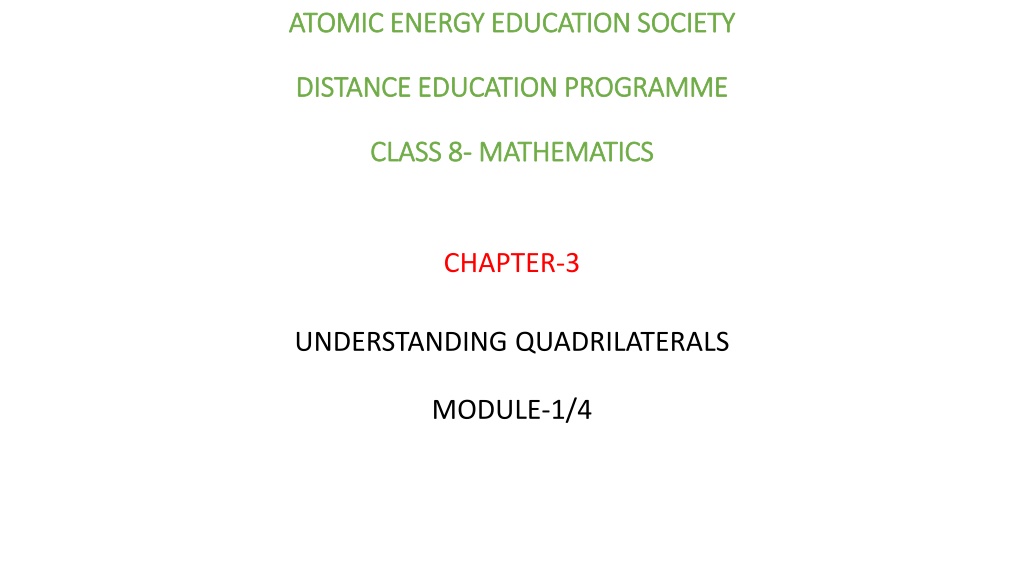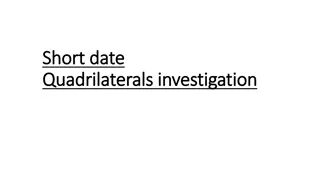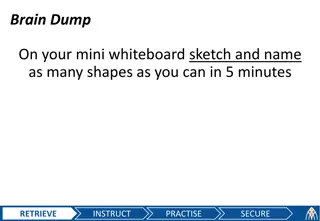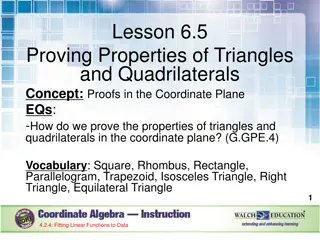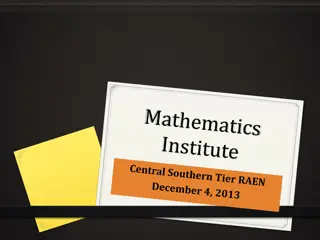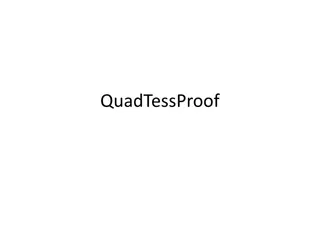Exploring Quadrilaterals in Mathematics Education
This educational content delves into the understanding of quadrilaterals in mathematics, covering topics such as polygons, convex and concave shapes, regularity, diagonals, and angle properties. Through detailed explanations and visual aids, viewers can grasp the fundamental concepts and properties of various polygon types.
Download Presentation

Please find below an Image/Link to download the presentation.
The content on the website is provided AS IS for your information and personal use only. It may not be sold, licensed, or shared on other websites without obtaining consent from the author. Download presentation by click this link. If you encounter any issues during the download, it is possible that the publisher has removed the file from their server.
E N D
Presentation Transcript
ATOMIC ENERGY EDUCATION SOCIETY ATOMIC ENERGY EDUCATION SOCIETY DISTANCE EDUCATION PROGRAMME DISTANCE EDUCATION PROGRAMME CLASS 8 CLASS 8- - MATHEMATICS MATHEMATICS CHAPTER-3 UNDERSTANDING QUADRILATERALS MODULE-1/4
Module-1 1) Polygon - Definition 2) Classification of polygons 3) Diagonal of a polygon 3)Convex & concave polygons 4)Regular and Irregular polygons 5)Angle sum property of a quadrilateral 6) Angle sum property of a polygon 7) Problems.
3. Understanding quadrilaterals Let us learn some terms like polygon, convex &concave polygon, regular & irregular polygon. 1)Polygon- A simple closed figure made up of only line segments is called a polygon.
2) For a figure to be a polygon we need minimum 3 line segments. Polygons are classified according to the number of sides. Classification of polygons is as follows.
3) Diagonal of a polygon Diagonal of a polygon- -A line segment joining two non-consecutive vertices is called as a diagonal. Let us see how many diagonals are there in the following polynomials.
Can you generalise this for a polynomial having n sides? No. of diagonals of a polygon = ?(? 3) of n sides Note There is only one polygon which has number of sides and number of diagonals same and it is pentagon. , n> 3 2 4) Convex and Concave polygon A polygon is said to be a convex polygon if the line segment joining any two points in its interior lies completely in its interior. A polygon which is not convex Is called as concave polygon.
You can see that in a convex polygon each of the interior angles is less than 180 You can see that in a convex polygon each of the interior angles is less than 180 where as in a concave polygon you can see that one of the interior angles is greater than 180 concave polygon you can see that one of the interior angles is greater than 180 .Also in a convex polygon no portion of the diagonal is in its exterior. In a concave polygon one of the convex polygon no portion of the diagonal is in its exterior. In a concave polygon one of the diagonal except its end points lies in the exterior of the polygon diagonal except its end points lies in the exterior of the polygon. where as in a .Also in a Let us see some more convex and concave polygons.
6) Regular and Irregular polygons 6) Regular and Irregular polygons A polygon is said to be a regular polygon if all its sides and all its angles are equal. Let us see some examples of regular and irregular polygons. Regular polygons Irregular polygons
7) Angle sum property of a polygon 7) Angle sum property of a polygon We know that sum of the angles of a triangle is 180 .Let us find the sum of the angles of a quadrilateral. Type equation here.
This is an activity in which all the four angles of the quadrilateral ABCD are cut and joined together forming a circle. This implies that sum of the four angles of a quadrilateral is 360 or 2 straight angles or 4 right angles. i. e. A + B + C + D = 360
Let us prove that sum of the angles of a quadrilateral is360 In ABC , 4 + 5 + 6 = 180 -----(1) In ACD , 1 + 2 + 3 = 180 -----(2) Adding equations (1) and (2), we get, 4 + 5 + 6 + 1 + 2 + 3 = 180 + 180 Or, ( 1 + 4) + 6 + ( 2 + 5) + 3 = 360 Or, A + B + C + D = 360 Hence , sum of the angles of a quadrilateral is 360
Figure No. of sides No. of triangles Angle sum 2 x 180 = 360 4 2 3 x 180 = 540 5 3 (n -2) x 180 n n-2
You have seen that in a quadrilateral the no. of triangles formed is 2.In a pentagon the no. of triangles formed is 3.So you can observe that in a polygon the number of triangles is two less than that of the number of sides. In a quadrilateral , no. of triangle =2 Therefore, angle sum of a quadrilateral = 2 x180 =360 In a pentagon, no. of triangles =3 Hence , angle sum of a pentagon= 3 x 180 = 540 In general, angle sum of a polygon of n sides= (n-2) x 180
Practice Problems Q.1.Find the sum of angles of a convex polygon of 8 sides. Soln. We know, angle sum of a polygon of n sides = (n-2) x 180 Number of sides = 8 ,i.e. It is an octagon. sum of angles of an octagon = ( 8 -2) x 180 =6 x 180 = 1080 Q.2. The angles of a quadrilateral are 120 , 130 , 50 .Find the fourth angle. Soln. Let the measure of the fourth angle be = x
We know that sum of the angles of a quadrilateral is = 360 We know that sum of the angles of a quadrilateral is = 360 So, So, 120 120 +130 130 + 50 50 + x x = 360 = 360 i.e. i.e. 300 300 + x + x = 360 = 360 , Thus, x , Thus, x = 360 = 360 - - 300 300 = 60 = 60 Q.3 Find the measure of each of the interior angle of a regular pentagon. Soln. In a regular polygon, we know that, ? 2 ? 180 ? 5 2 ? 180 5 measure of interior angle = = = 3 ? 180 = 540 5 5 Measure of each int. angle of a regular pentagon = 108
Q.4. Find the angles of a quadrilateral if its angles are in the ratio 1:2;3:4 Q.4. Find the angles of a quadrilateral if its angles are in the ratio 1:2;3:4 Soln. Let the angles of a quadrilateral be x,2x,3x & 4x Soln. Let the angles of a quadrilateral be x,2x,3x & 4x By angle sum property of a quadrilateral, we get x +2x +3x +4x = 360 10x = 360 x = 360/10 =36 2x = 2 x 36 =72 3x = 3 x 36 = 108 4x = 4 x 36 = 144 Thus 4 angles of the quadrilateral are 36 , 72 , 108 , 144 .
Worksheet 1 Worksheet 1 Module1/4 Module1/4 Understanding Quadrilaterals Understanding Quadrilaterals Q.1. Fill in the blanks 1. A quadrilateral has ------diagonals. 2. The sum of the angles of a quadrilateral is ------. 3. The sum of the angles of a quadrilateral is ----- right angles. 4. The number of sides and the number of diagonals is same in a --. 5. The regular polygon having 4 sides is called a -----. Q.2. The angles of a quadrilateral are in the ratio 3:5:7:9. Find the angles of the quadrilateral.
Q.3 .3. . Three angles of a quadrilateral are equal. Fourth angle is of measure Three angles of a quadrilateral are equal. Fourth angle is of measure 150 150 . What is the measure of each of the equal angles ? . What is the measure of each of the equal angles ? Q. 4.Three angles of a quadrilateral are 110 Q. 4.Three angles of a quadrilateral are 110 ,50 its its fourth angle. fourth angle. Q.5. If the sum of two angles of a quadrilateral is 180 , what is the sum of remaining two angles? Q.6. How many sides has a regular polygon, each angle of which is of measure 108 ? Q.7. The interior angle of a regular polygon is 156 . Find the number of sides of the polygon. Q.8. What is the measure of each angle of a regular hexagon ? Q.9. Find x in the figure shown aside. ,50 and 40 and 40 . find the measure of . find the measure of
Thank You Made by- Bhavana Dale AECS-1,TARAPUR
